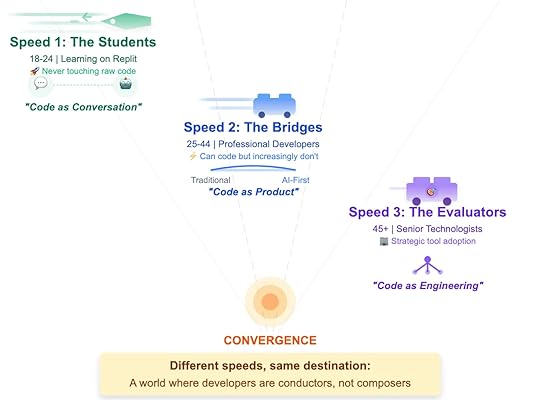The Vibe Coding Convergence

The story of AI in software development is often told as a battle between different cohorts—students experimenting on Replit, professionals adopting Cursor, and senior technologists evaluating platforms like Base44. Each group moves at its own speed, shaped by its demographic position, cultural norms, and organizational responsibilities. But the deeper truth is that these speeds are not diverging—they are converging.
The destination is clear: a world where developers are no longer composers of code, but conductors of intelligent systems.
Speed 1: The Students – Code as ConversationFor those aged 18-24, especially those learning on platforms like Replit, coding begins as conversation.
They are never touching raw code in the traditional sense.Their entry point is directing AI, not memorizing syntax.To them, programming is prompting.This generation will not carry the burden of unlearning manual craft. Instead, they will grow up fluent in orchestration, treating AI as the default collaborator from day one. Their speed comes from ignoring elegance and diving straight into output.
Speed 2: The Bridges – Code as ProductThe 25-44 professional developer cohort represents the bridge generation.
They can code, but increasingly they don’t.They are shifting from traditional practices toward AI-first development.For them, code is not a technical artifact but a product to be shipped, tested, and iterated.This group is the decisive layer of transformation. They know the risks of AI outputs, but they embrace the trade-off because they also know that speed beats perfection. They are the ones normalizing AI in production, shifting organizational norms, and redefining what “production-ready” means.
Their speed comes from balancing credibility (they still know how to code) with flexibility (they increasingly don’t bother).
Speed 3: The Evaluators – Code as EngineeringSenior technologists aged 45+—architects, technical leads, and decision-makers—approach the shift with caution.
They see code as engineering.Their priority is strategic tool adoption at scale, not daily coding.They emphasize governance, maintainability, and compliance.Their speed is the slowest, but their influence is the broadest. Once they validate a tool, it spreads across enterprises. They are the bottleneck through which AI coding tools must pass to achieve enterprise-wide adoption.
Their speed comes not from building quickly, but from making systemic decisions that scale slowly yet irreversibly.
Different Speeds, Same DestinationAt first glance, these groups seem to be pulling in different directions:
Students abandoning syntax altogether.Bridges compromising elegance for velocity.Evaluators insisting on governance and architecture.But the convergence point is unmistakable: a world where developers orchestrate AI rather than compose code line by line.
The metaphor of composer no longer applies. In the old world, developers were like classical composers, carefully writing every note. In the new world, they are conductors—guiding intelligent instruments that generate music dynamically. The artistry lies not in the raw writing, but in the direction, coordination, and interpretation.
Why Convergence is InevitableThree structural forces drive this convergence:
Market Pressure: The startup ecosystem proves that speed dominates. When Y Combinator companies rely on 95% AI-generated code, the standard shifts for everyone. Enterprises cannot afford to ignore what the market validates.Tool Evolution: Platforms are adapting to each demographic. Replit lowers the barrier for students, Cursor optimizes for professionals, Base44 integrates governance for enterprises. But all tools are converging on the same outcome: AI at the center of production.Cultural Reinforcement: Each group influences the others. Students normalize orchestration, bridges prove it works in production, evaluators eventually adopt it at scale. This cultural flywheel ensures alignment despite initial resistance.The Cost of ConvergenceConvergence does not mean harmony. The shift comes with costs:
Quality Decline: As shown in the quality paradox, AI outputs often contain errors, refactoring declines, and debugging increases.Skill Erosion: A generation may emerge without deep manual coding literacy, leaving gaps in debugging and system-level understanding.Technical Debt: Accepting speed-first development leads to ballooning long-term maintenance challenges.Yet these costs are tolerated because the benefits—velocity, market capture, and adaptability—are strategically more valuable.
The Cultural Reframing of the DeveloperConvergence also transforms the cultural identity of the developer.
In the old model, prestige came from composing elegant code.In the new model, prestige comes from conducting effective systems.The hero is no longer the coder who writes the clever algorithm, but the orchestrator who ships the working product at speed.This reframing will shape education, career trajectories, and even how organizations structure their teams.
Implications for the FutureFor Students: Learning syntax may become secondary to learning orchestration, evaluation, and system-level thinking.For Professionals: The career premium lies in mastering the balance—knowing enough code to debug but focusing on shipping with AI.For Enterprises: Procurement priorities will increasingly value tools that support orchestration at scale, not manual craft.For the Industry: The software economy will tilt toward platforms that optimize for orchestration rather than pure engineering elegance.Conclusion: Developers as ConductorsThe diagram captures the essence of the transformation: different speeds, same destination.
Students move fast, skipping manual craft.Bridges move at medium speed, adopting AI-first pragmatism.Evaluators move slowly, ensuring governance.But all converge toward the same reality: developers are becoming conductors, not composers.
The significance cannot be overstated. Once orchestration becomes the baseline, the very definition of “software development” changes. Coding will no longer mean writing—it will mean directing. The future of the developer is not in the fingers typing syntax but in the mind orchestrating intelligence.

The post The Vibe Coding Convergence appeared first on FourWeekMBA.



